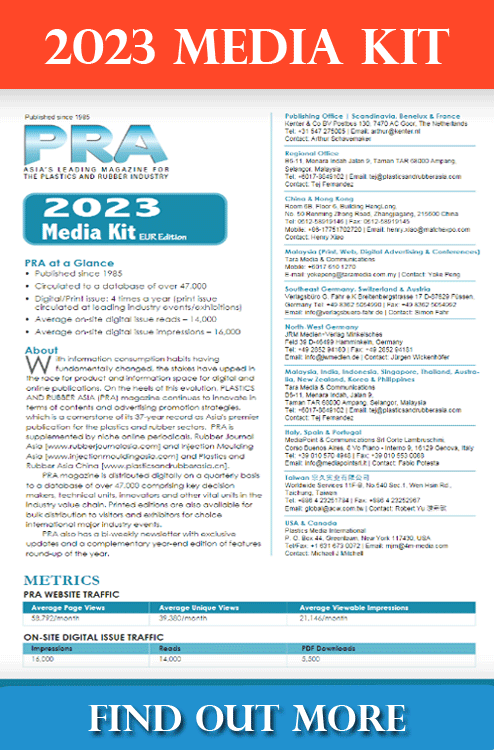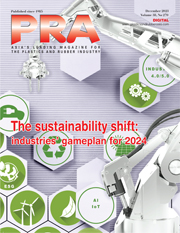Sustainability: Asian industries’ staying power via sustainable practices

Industries are moving towards a confluence of supply chain resilience, sustainable practices, and technology advancements, according to this interview with consulting firm EY.
Supply chain resilience in a disruptive era
Supply chain resilience is pivotal in the face of economic, political, and environmental disruptions. Plastics and Rubber Asia (PRA) interviewed Atul Chandna, EY AsiaPacific Supply Chain Leader, who discussed the benefits and challenges of attaining sustainability against the backdrop of evolving policies, standards, and technological breakthroughs. Chandna underscores the need for adaptability and localised operations to mitigate risks.
PRA: Could you elaborate on the strategic shifts towards sustainable supply chains and the role they play in enhancing resilience?
Atul Chandna: Various disruptions such as Covid-19, geopolitical tensions, and ESG (Environmental, Social and Governance) pressures significantly impact manufacturers and exporters. As the world becomes highly interconnected, manufacturers and exporters are required to possess exceptional competencies for a competitive advantage.
Relatedly, transitioning to a circular model simplifies sourcing and enhances sustainability. Supplier and component selection according to ESG and United Nations (UN) Sustainable Development Goals (SDG) guidelines are among the other important aspects to consider. Sustainable supply chains are becoming imperative.
Additionally, localised supply chains through nearshoring/ reshoring reduce the risks of disruptions. Shorter chains enable faster responses to changes in demand, improve margins, and reduce tariffs and the carbon footprint.
Integration of ESG Principles for sustainable development
ESG represents a body of practices that organisations adopt to mitigate negative impacts or amplify positive influences on the environment, society, and governance frameworks. It serves as the bedrock for sustainable development, advocating concerted efforts aimed at fostering an inclusive, sustainable, and resilient future for both people and the planet.
In line with the UN’s perspective, accomplishing sustainable development relies on the harmonisation of three pivotal components: economic advancement, societal inclusivity, and safeguarding the environment, all of which collectively contribute to the well-being of individuals and societies.
Chandna sheds light on how manufacturers are progressing in integrating ESG concepts into their supply chain strategy
PRA: Given recent economic and political disruptions, industries are now more aware of the importance of adopting strategies to safeguard their businesses. Similarly, ensuring supply chain resilience has become imperative. How are manufacturing companies stepping up, such as by incorporating ESG principles into their supply chain strategies, to bolster resilience and mitigate risks?
Atul Chandna: In today's VUCA (volatile, uncertain, complex and ambiguous) world, our clients in the manufacturing sector increasingly recognise the value of integrating ESG principles into their supply chain strategies. These initiatives include risk mapping, supplier assessment and diversification, and continuous monitoring.
To effectively manage risks, the first step is mapping and assessing vulnerabilities across the supply chain, considering environmental risks, social impacts, and governance issues. This understanding enables companies to develop targeted strategies to mitigate risks and enhance supply chain resilience.
Manufacturing companies are also conducting thorough assessments of their suppliers' sustainability practices, evaluating environmental performance, labour conditions, ethical sourcing, and regulatory compliance. By working with suppliers committed to ESG principles, companies can mitigate risks and improve the overall sustainability of their supply chains.
Supplier diversification also minimises disruptions caused by natural disasters, geopolitical events or shifts in the market.
Long-term risk management and resilience planning rely on continuous monitoring of key sustainability indicators. This process allows companies to identify potential risks and take proactive measures to address environmental impact, labour practices, and governance issues within their supply chains.
Technology as a catalyst for resiliency
Enhancing the adoption of AI-powered technologies and analytics for optimising supply chains represents the path forward. Chandna foresees a future where autonomous supply chains swiftly adapt to demand fluctuations, fostering unparalleled flexibility and efficiency.
PRA: What role does technology play in enhancing supply chains?
Atul Chandna: To gain a competitive advantage, the industry needs to leverage Artifical Intelligence (AI)- powered technologies and advanced analytics, which will increasingly reduce opacity and other complexities in today’s supply chains. This technology aids in sustainable sourcing, compliance, and the creation of a seamlessly integrated supply chain.
Projections suggest that by 2035, 45% of supply chains will likely be mostly autonomous. This advancement enables exporters and manufacturers to instantly respond to changes in customer demand, adjusting supply plans and production schedules in real-time. Consequently, the supply chain becomes more flexible, efficient, and optimised.
(PRA)
Subscribe to Get the Latest Updates from PRA Please click here
©2023 Plastics and Rubber Asia. All rights reserved.

©2023 Plastics and Rubber Asia. All rights reserved.
Home Terms & Conditions Privacy Policy Webmail Site Map About Us
















